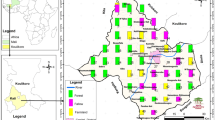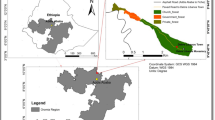Abstract
Populations of naturally growing woody species valued for their contribution to human livelihoods are threatened with extinction. Most at risk are those existing in human inhabited areas outside protected areas that are subjected to high population pressure and to a variety of land use demands. The sustainable utilization of these plants requires as a first step knowledge, including, their ecology and an understanding of the peoples attitudes to conservation. This study was conducted to generate data that would contribute to the management for conservation and sustainable use of woody resources. The study objectives were to document local knowledge covering the uses, status, threats, habitats and management solutions of woody species; determine the abundances, distribution and population structure of 16 woody species, and assess the conservation status of the selected woody species. The study was carried out in Gadumire Sub-county, Uganda using both an ethnobotanical approach and quantitative ecological methods. The species are multipurpose and are exploited to satisfy different subsistence needs. They had population densities ranging between 3.6 and 2630 individuals ha−1, and distributions ranging between 0.3 and 39.5%. The species Acacia hockii, Albizia zygia, Acacia seyal, Markhamia lutea and Albizia coriaria had a good conservation status. The remainder of the species appear threatened either because they had low densities, frequencies or less steep size class distribution (SCD) slopes. Securidaca longipedunculata Fres. was not encountered at all in the study plots. Community perceptions collaborated the measured population dynamics. The major threats believed to be impacting the species by the community are the growing human population, expanding crop agriculture, poor harvesting methods and over-exploitation of the species.






Similar content being viewed by others
References
Aumeeruddy Y (1994) Local representations and management of agroforests on the periphery of Kerinci Seblat National Park, Sumatra, Indonesia, People and plants working paper 3. Paris, UNESCO
Condit R, Sukumar R, Hubbell SP, Foster RB (1998) Predicting population trends from size distributions: a direct test in a tropical tree community. Am Nat 152:495–509
Cunningham AB (1993) African medicinal plants: setting priorities at the interface between conservation and primary health care. People and plants working paper 1. Paris, UNESCO
Cunningham AB (2001) Applied ethnobotany: people, wild plant use & conservation. People and plants conservation manual. Earthscan Publications Ltd., London
Dalle SP, López H, Díaz D, Legendre P, Potvin C (2002) Spatial distribution and habitats of useful plants: an initial assessment for conservation on an indigenous territory, Panama. Biodivers Conserv 11:637-667
Department of Land and Survey (1962) Atlas of Uganda. Department of Land and Survey, Uganda, Entebbe, pp 22–23
Forest Department (1997) The National Biomass Study. Land Cover Stratification map, Bulamogi County. Forest Department, Uganda, Kampala
Government of Uganda (1963) Map Series Y732: Sheets 52/4, 53/3. Scale 1:50 000 edn. I-DOS. Directorate of Overseas Survey for Uganda Government, Entebbe
Hall P, Bawa K (1993) Methods to assess the impact of extraction of non-timber tropical forest products on plant populations. Econ Bot 47:234–247
Jongman RHG, ter Braak CJF, van Tongeren OFR (eds) (1995) Data analysis in community and landscape ecology. Cambridge University Press, UK, p 137
Kaimowitz D, Mertens B, Wunder S, Pacheco P (2004) Hamburger connection fuels Amazon destruction: Cattle ranching and deforestation in Brazil’s Amazon. Bogor, CIFOR
Konstant TL, Sullivan S, Cunningham AB (1995) The effects of utilization by people and livestock on Hyphaene petersiana (Arecaceae) basketry resources in the palm savanna of North-Central Namibia. Econ Bot 49:345–356
Langdale-Brown I, Osmaston HA, Wilson JG (1964) The vegetation of Uganda and its bearing on land-use. Uganda Government, Kampala
Lykke AM (1998) Assessment of species composition change in savanna vegetation by means of woody plants’ size class distributions and local information. Biodivers Conserv 7:1261–1275
National Environment Management Authority (2002) State of the environment report for Uganda 2002. National Environment Management Authority, Kampala
Obiri J, Lawes M, Mukolwe M (2002) The dynamics and sustainable use of high-value tree species of the coastal Pondoland forests of the Eastern Cape Province, South Africa. For Ecol Manage 166:131–148
Ollier CD, Harrop JF (1959) The soils of the Eastern Province of Uganda: a reconnaissance survey, memoirs of the research division, series I: soils, number 2. Department of Agriculture, Kawanda Research Station, Kampala
Peters CM (1999) Ecological research for sustainable non-wood forest product exploitation: an overview. In: Sunderland TCH, Clark LE, Vantomme P (eds) Non-wood forest products of central africa: current research issues and prospects for conservation and development. Food and Agriculture Organization, Rome, pp 19–35
Primack RB (1998) Essentails of conservation biology, 2nd edn. Sinauer Associates Inc., Massachusets USA
Rosa EA, York R, Dietz T (2004) Tracking the anthropogenic drivers of ecological impacts. Ambio 33(8):509–512
Schippmann U, Leaman DJ, Cunningham AB (2002) Impact of cultivation and gathering of medicinal plants on biodiversity: global trends and issues. In biodiversity and the ecosystem approach in agriculture, forestry and fisheries: satellite event on the occasion of the ninth regular session of the commission on genetic resources for food and agriculture. Rome, 12–13 October 2002, FAO, Rome
Shackleton SE, Dzerefos CM, Shackleton CM, Mathabela FR (1998) Use and trading of wild edible herbs in the central Lowveld Savanna region, South Africa. Econ Bot 52:251–259
Tabuti JRS, Dhillion SS, Lye KA (2003a) Ethnoveterinary medicines for cattle (Bos indicus) in Bulamogi county, Uganda: plant species and mode of use. J Ethnopharmacol 88:279–286
Tabuti JRS, Dhillion SS, Lye KA (2003b) Fuelwood use in Bulamogi County, Uganda: species harvested and consumption patterns. Biomass Bioenerg 25:581–596
Tabuti JRS, Dhillion SS, Lye KA (2004) The status of wild food plants in Bulamogi County, Uganda. Int J Food Sci Nutr 55:485–498
Tabuti JRS, Lye KA, Dhillion SS (2003c) Traditional herbal drugs of Bulamogi, Uganda: plants, use and administration. J Ethnopharmacol 88:19–44
Ticktin T (2004) The ecological implications of non-timber forest products. J Appl Ecol 41:11–21
Twine WC (2005) Socio-economic transitions influence vegetation change in the communal rangelands of the South African lowveld. Afr J Range For Sci 22:93–99
Uganda Bureau of Statistics (2005) The 2002 Uganda population and housing census—main report. UBoS, Kampala
Uganda Participatory Poverty Assessment Process (2002) Deepening the understanding of poverty: second participatory poverty assessment report. Ministry of Finance Planning and Economic Development, Kampala
Walter S (2001) Non-wood forest products in Africa: A regional and national overview. FAO
Acknowledgements
Permission to carry out this research was granted by the Uganda National Council for Science and Technology (Research No. EC 606). Funding for the study was provided by NORAD. The community of Gadumire Sub-county is acknowledged for collaborating on this study. The following people A-M. Lykke, J.M. Kasenene, P. Mucunguzi, J. Kalema, H. Tushabe and two anonymous referees are thanked for their comments on different aspects of the research. P. Sebulime assisted with field work.
Author information
Authors and Affiliations
Corresponding author
Rights and permissions
About this article
Cite this article
Tabuti, J.R.S. The uses, local perceptions and ecological status of 16 woody species of Gadumire Sub-county, Uganda. Biodivers Conserv 16, 1901–1915 (2007). https://doi.org/10.1007/s10531-006-9097-7
Received:
Accepted:
Published:
Issue Date:
DOI: https://doi.org/10.1007/s10531-006-9097-7




